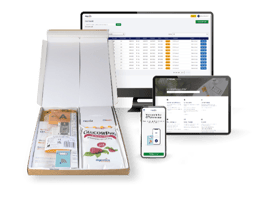At-home diabetes test could be a significant breakthrough for type-1 diabetes screening
At-home diabetes test could be a significant breakthrough for type-1 diabetes screening
NHS Hospital Trust Pilot of New Testing Technology Sees Pregnant Women in Southampton Become the First Patients Globally to Access Gestational Diabetes Testing at Home.
NHS Hospital Trust Pilot of New Testing Technology Sees Pregnant Women in Southampton Become the First Patients Globally to Access Gestational Diabetes Testing at Home.
Oxford, United Kingdom 17/01/2025 – A new at-home test to diagnose type-1 diabetes (T1D) is being investigated in a major UK study led by researchers at the National Institute for Health and Care Research (NIHR) Oxford Biomedical Research Centre. The study will invite 90 children and young people across two groups to assess the test and determine whether at-home T1D testing could be used routinely across the NHS.
The study will assess the GTT@home test, developed by British digital clinical diagnostics and diabetes home testing provider Digostics, for use with children. GTT@home is an Oral Glucose Tolerance Test (OGTT) that uses finger-prick blood samples to measure how well the body processes glucose, and has been shown to be as accurate as hospital-based OGTTs when used with adults.
.png?width=564&height=500&name=Stock%20Image%20-%20Woman%20with%20Baby%20-%20Test%202%20+%20Blue%20Tramline%20-%20Left%20and%20Right%20(3).png)
The GTT@home test has already been successfully implemented at NHS trusts in South East England, with more than 2,500 women screened for gestational diabetes in pregnancy since its recent launch. This will be the first study in children.
Study lead Rabbi Swaby, Clinical Research Fellow in the Nuffield Department of Medicine, commented: “Early diagnosis of T1D relies on OGTTs, but we know these tests are not well tolerated, especially by very young children. At-home testing could be a major breakthrough for reducing the burden of testing. We look forward to seeing the results of our study to help us understand how GTT@home might be used in routine care.”
.png?width=564&height=500&name=Stock%20Image%20-%20Woman%20with%20Baby%20-%20Test%202%20+%20Blue%20Tramline%20-%20Left%20and%20Right%20(4).png)
T1D is the most common childhood autoimmune disease, affecting around one in 350 children. It is caused by the destruction of the insulin-producing cells in the pancreas, resulting in elevated blood glucose levels. It affects every aspect of health and wellbeing, resulting in life-long insulin dependence and an increased risk of major health problems such as heart disease, blindness, and kidney failure, as well as premature death.
The development of T1D is now well understood and comprises 4 stages. Stage 1 is the start of T1D, when the presence of autoantibodies confirms the autoimmune destruction of the cells that produce insulin. In Stage 2, reduced insulin production leads to elevated blood glucose levels. In Stage 3 an individual has the clinical diagnosis of T1D and symptoms may begin to appear due to significant loss of insulin-producing cells. Stage 4 is the long-term stage of T1D, requiring consistent insulin management to control blood glucose levels.
The OGTT is the gold-standard test recommended for defining which stage a person with T1D is in and is the most sensitive test for monitoring for the early onset of Stage 3. Hospital-based OGTTs are often not well tolerated because they require a drip inserted into the vein, and several blood samples taken over 2-3 hours in a healthcare setting.
T1D is estimated to cost the UK over £1.8bn every year. In around 40% of children the diagnosis of T1D is not made until the child has become severely unwell and in “diabetic ketoacidosis” (DKA), a life-threatening diabetes complication. An effective T1D screening programme would help to diagnose T1D in children before they enter DKA.
The GTT@home test kit contains the test device, finger prickers for blood sample collection, a preformulated glucose drink, and detailed instructions. The process begins with an initial finger prick blood sample, followed by the consumption of the glucose drink. Two hours later, a second blood sample is taken. With standard hospital-based OGTTs, children would have had to fast overnight, travel to a clinic early in the morning and then undergo the two blood draws two hours apart while remaining fasted.
The GTT@home device immediately analyses both blood samples and shares accurate and timely results directly with the study teams. Immediate analysis of samples eliminates the risk of sample degradation that can affect hospital-based OGTTs when samples are not sent to the lab immediately, improving diagnostic reliability.
“We are very pleased to be partnering with the NIHR Oxford Biomedical Research Centre on this study," said James Jackson, CEO and Founder of Digostics. "We believe that there is huge potential for the widespread use of at-home OGTT testing to diagnose T1D. Not only is it more attractive for young children to be able to be tested at home, but the results from our GTT@home test are not affected by the time-dependent sample degradation that can lead to false negative OGTT results with in-clinic testing."
Dr Rachel Besser, who leads the T1Early programme at the University of Oxford and is overseeing this work, said “A more practical and reliable alternative to the in-clinic OGTT would be a welcome advance and could improve the experience and therefore the uptake of children who have an OGTT as part of their care.”

"We hope this revolutionary new at-home test is going to dramatically change the way we deliver gestational diabetes testing during antenatal care."
Dr Matthew Coleman




Click the button below for more GTT@home product-specific information exploring:
• the GTT@home test kit's contents
• the novel GTT@home test device
• at-home versus in-clinic test comparisons
• patient and healthcare professional support


Click the button below for more GTT@home product-specific information exploring:
• the GTT@home test kit's contents
• the novel GTT@home test device
• at-home versus in-clinic test comparisons
• patient and healthcare professional support
About Digostics
Far too many people across the world are living with undiagnosed diabetes.
UK-based Digostics' mission is to enable healthcare providers to identify everyone with diabetes, and those at risk of developing diabetes, by eliminating the common barriers that inhibit accurate and timely testing using the gold standard oral glucose tolerance test (OGTT).
Digostics is proud to offer GTT@home - the world’s first home OGTT offering and the most accessible and scalable way for clinical teams to realise their diabetes testing objectives.
To learn more, visit www.digostics.com
About The National Institute for Health and Care Research (NIHR)
Oxford Biomedical Research Centre (BRC) is based at the Oxford University Hospitals NHS Foundation Trust and run in partnership with the University of Oxford.
The mission of the National Institute for Health and Care Research (NIHR) is to improve the health and wealth of the nation through research. We do this by:
-
funding high quality, timely research that benefits the NHS, public health and social care;
-
investing in world-class expertise, facilities and a skilled delivery workforce to translate discoveries into improved treatments and services;
-
partnering with patients, service users, carers and communities, improving the relevance, quality and impact of our research;
-
attracting, training and supporting the best researchers to tackle complex health and social care challenges;
-
collaborating with other public funders, charities and industry to help shape a cohesive and globally competitive research system;
-
funding applied global health research and training to meet the needs of the poorest people in low- and middle-income countries.
About University Hospital NHS Foundation Trust
University Hospital Southampton NHS Foundation Trust provides services to some 1.9 million people living in Southampton and south Hampshire, plus specialist services such as neurosciences, cardiac services and children's intensive care to more than 3.7 million people in central southern England and the Channel Islands.
UHS is one of the largest acute teaching trusts in England with a staff of 13,000 and a turnover of more than £1bn in 2020/21.
We are one of only two major trauma centres in the South of England for both adults and children.
UHS is consistently one of the UK’s highest recruiting trusts of patients to clinical trials.
Could GTT@home be of assistance to your patients?
Please get in touch by completing the form below or calling us on +44 (0)330 113 9145.
References
¹ International Diabetes Federation - Diabetes Atlas 10th Edition 2021
² NHS Gestational Diabetes Overview
³ International Diabetes Federation - Care and Prevention - Gestational Diabetes
† Pubmed - Future risk of diabetes in mother and child after gestational diabetes mellitus 2009
Images of Matthew Coleman and of University Hospital Southampton's premises are kindly provided by University Hospital Southampton NHS Foundation Trust.
